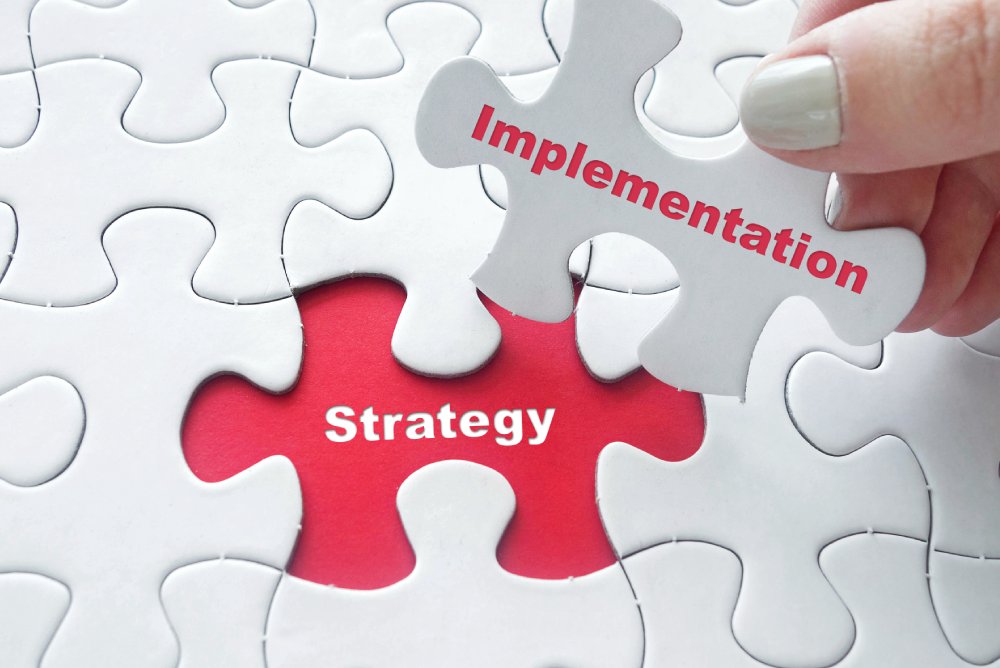- B2C Implementation Playbook
Context
Retailers often face challenges building and managing enterprise-grade eCommerce solutions, especially as they require specialized knowledge of a wide range of architectural principles, technologies, and cloud infrastructure.
The B2C Implementation Overview
A typical implementation includes the below listed phases, all of which contribute towards building a high quality, predictable solution, in-line with the customer expectations:
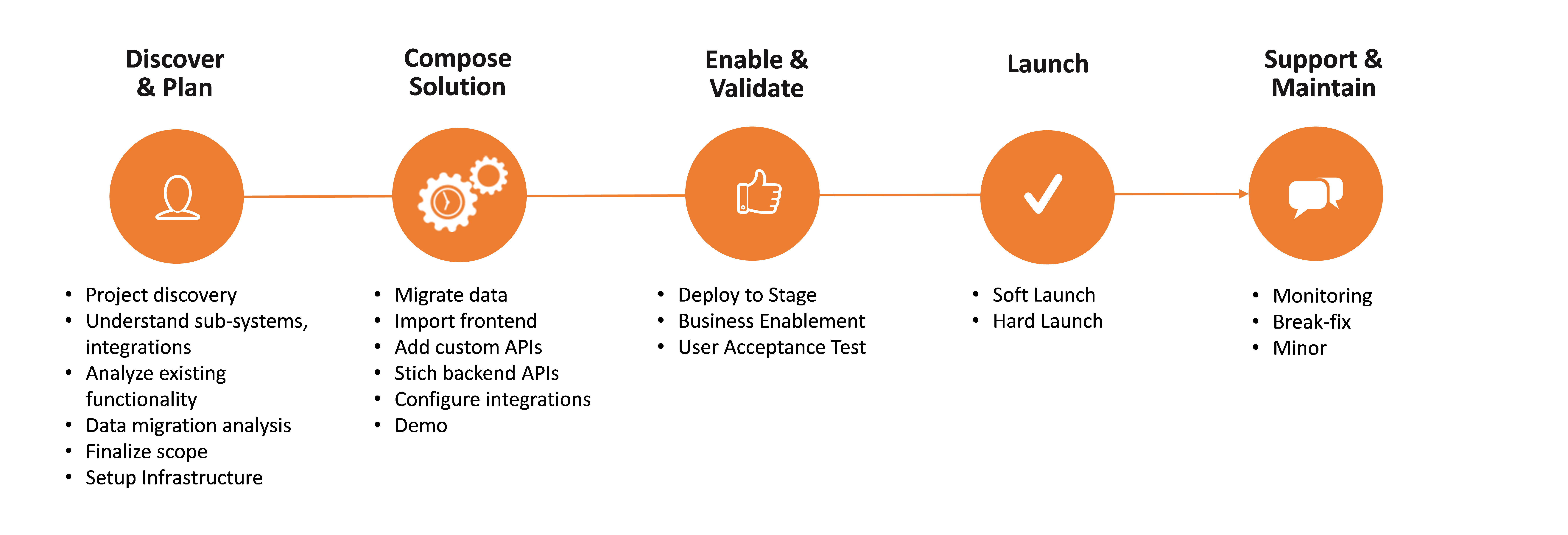
Discover & Plan Phase
- Gap Analysis One of the key reasons for project failure is sub-standard requirement analysis, i.e., not knowing “what” you are delivering. At AIE, we lay huge emphasis on the Requirement Mapping phase. We perform a detailed gap analysis of existing features/capabilities against those provided out-of-the-box (OOTB) by a specific platform capabilities
- Document Scope We gain a deep understanding of business needs, processes, systems interactions, and priorities. Our Business Analysts and System Analysts create detailed pre-reads which are shared with customer stakeholders. We then conduct sessions to walkthrough stakeholders through the details as required

- Finalize High Level Scope Business Analysts provide a walkthrough to key customer stakeholders who would then provide the approval and finalize the high-level scope
- High Level Project Plan: Once the scope is finalized, the project plan is created to give complete understanding to all stakeholders about the implementation journey. The key activities involved are:
- To develop a coarse-grained project plan for the entire Solution Composition phase, listing timelines, milestones, and deliverables
- All the critical processes, standards, and guidelines are weaved into the plan to ensure high quality deliverables
Entry Exit Criteria & Key Tasks:
- Identify key Customer & AIE stakeholders
- Conduct Functional workshops
- Share existing Solution artifacts
- Share existing solution artifacts
- Conduct Technical workshops – architecture, integrations, infrastructure, sizing & capacity
- Provide response to all clarifications
- AIE to analyse existing solution & post clarifications
- Create High level project plan
- Create Infrastructure definition
- Create High-level Data Migration approach
Compose Solution & Deploy
This phase involves the following activities/goals:
- Compose Solution
- To produce an architectural baseline for the solution
- To evolve the requirements model to a '80% completion point'
- To understand and eliminate the high-priority risks of the project

- Data Migration This activity covers the migration of all information from the current site to the TO-BE system. It includes all information related to:
- User data like billing/shipping address, past orders, cart, wishlist, gift list etc
- Business created data like catalog, product, category, price, inventory etc
- Site content – Blog posts, articles, photos etc
- Setup infrastructure This activity involves the GCP account setup, the infrastructure setup for the commerce engine, the business tools, content management component, Intelligent Search and Recommendation components, Database, Elastic Search components and fine-tuning them for optimum responsiveness, scaling and redundancy
- Import frontendEach webpage can be typically built as a combination of reusable components
Each individual component or block on the page is self-contained, which means, the CSS and JS scopes only to the structure of that component. This allows content authors to easily move components around the page without breaking the design
AIE Page designers will need web static assets from the customers including HTML, CSS styles, images, java scripts, videos etc. Designers will then use these assets and build reusable components and set them up in the TO-BE system
AIE web designers will ensure that the HTML components created are compliant to Web Content Accessibility Guidelines (WCAG). It is however the customers responsibility to ensure that images and videos and similar web assets shared are compliant to WCAG
The high-level activities involved in this phase are:
- Analyze wireframes or existing frontend solution
- check different components such as header, footer, navigation, body content, carousel components etc
- Decide if it needs to be further optimized
- design markup, identify style guide and typography
- incorporate image optimization
- Componentize the frontend
- Distinguish common or global components
- Design self-contained, reusable components
- Follow the ‘Experience editor’ first approach
- Incorporate best practices
- responsive, accessible
- mobile-first, compatible
- Agree on the contract with backend API
- Build custom APIsAIE can help build the backend microservices based APIs which support standard commerce features. In order to achieve the customers unique functionality, additional APIs might have to be created or existing APIs might have to be customized. This phase addresses these activities. We ensure that all code adheres to a “Steps of Doneness” which defines the completion of an activity
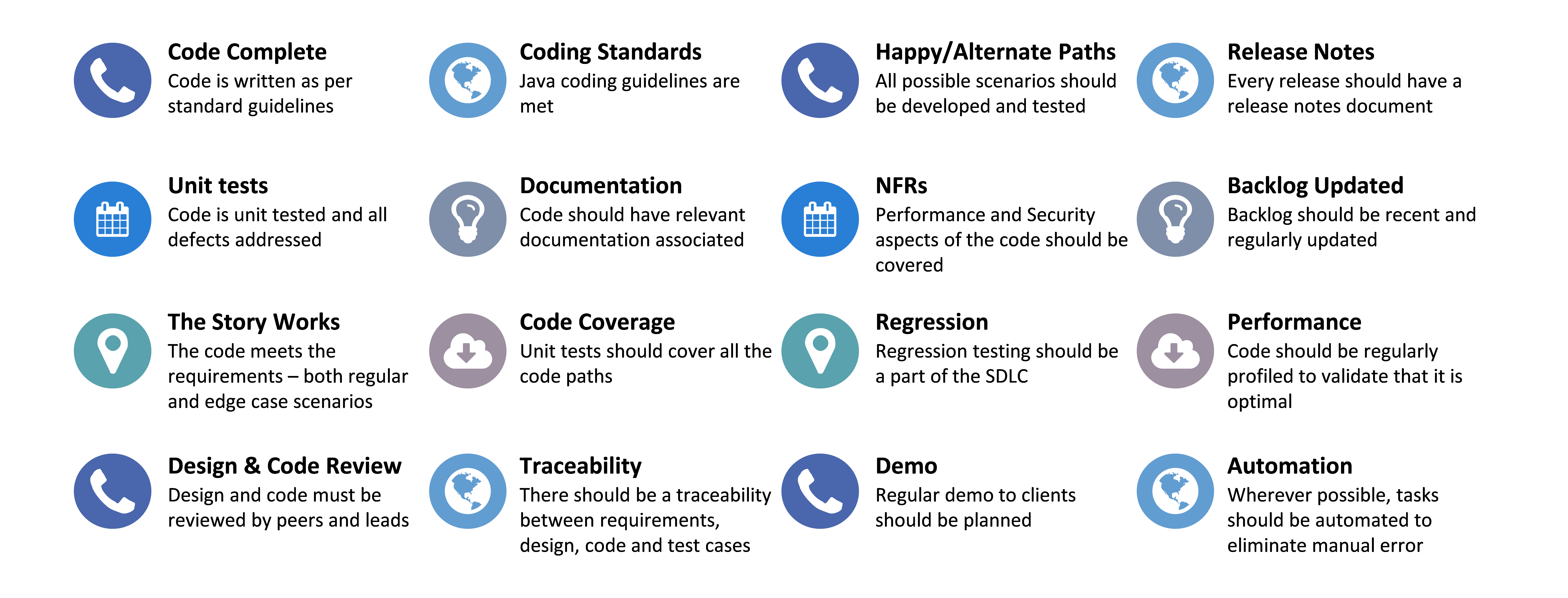
- Stitch backend APIs This activity involves integrating the frontend to the backend APIs and validating that they behave as expected
- Configure integrationsThis phase involves integrating the eCommerce solution with existing ecosystem integrations and validating the behaviour
- DeployAIE provides a robust DevOps solution which allows for code management, testing, monitoring, and deployment. The high-level DevOps solution is illustrated below:
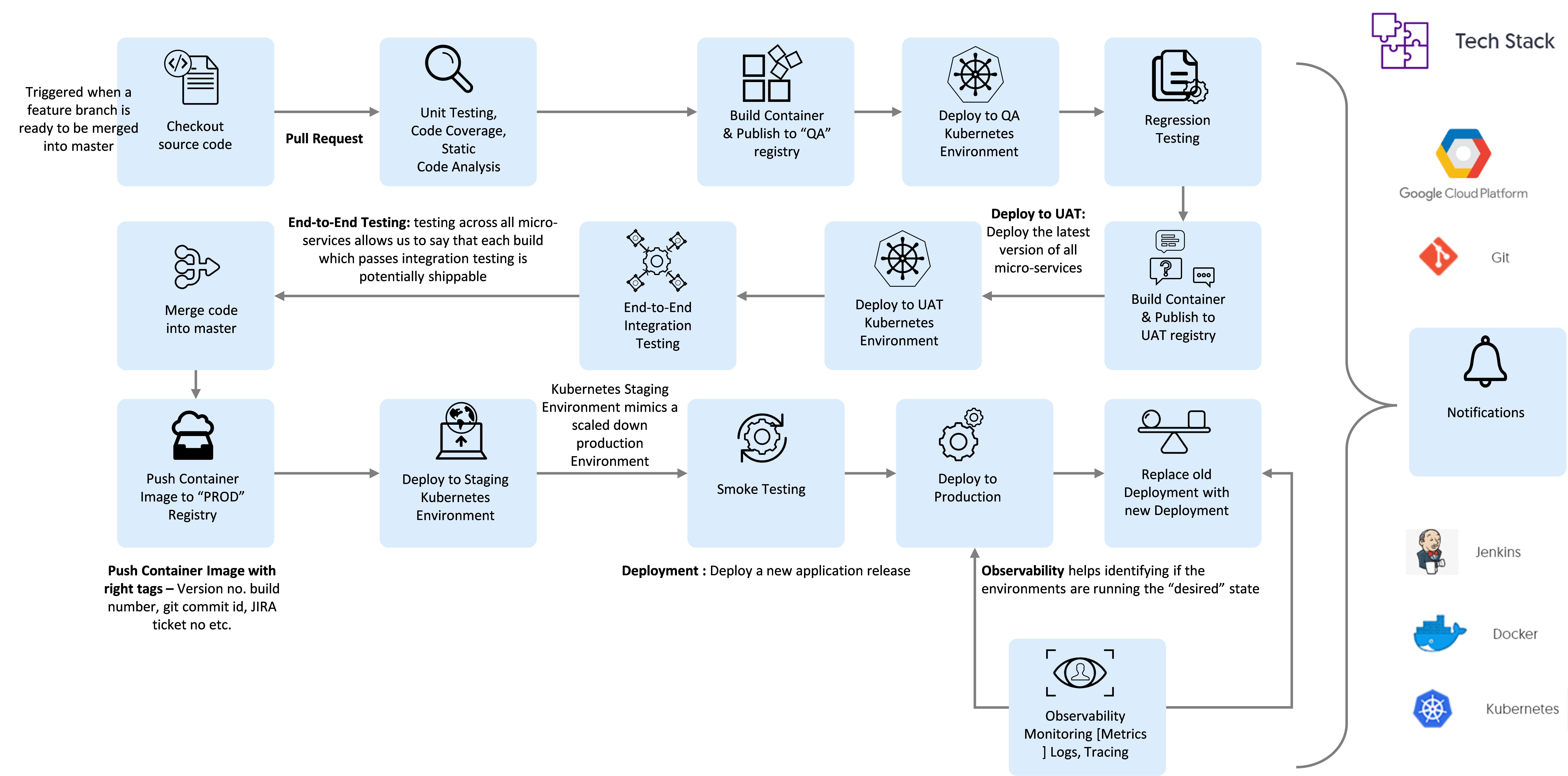
- Validate Solution At each stage, the solution is stringently validated and involves leveraging multiple aspects related to domain experience, relevant tools and process
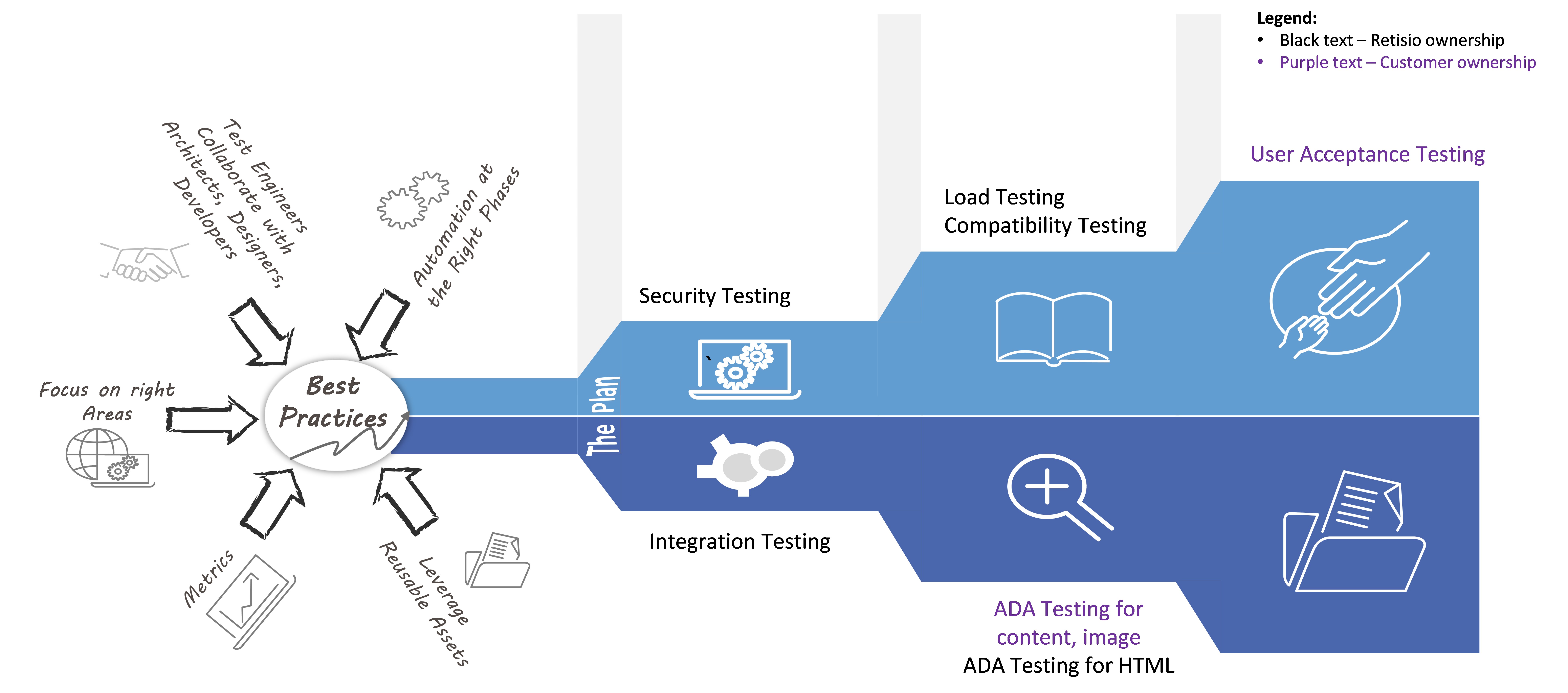
Entry Exit Criteria & Key Tasks:
- Approve Business Requirement Document (BRD)
- Sprint plan, test plan
- Sprint validated code deployed on high-level environment (possibly with mocks)
- Access to Jira, relevant customer systems, 3rd party integrations & request/response structure
- Sprint development, & validation - import frontend, stich backend APIs, add custom APIs, configure integrations
- Provide incremental approval to UCD, ISD
- Customer Demo
Enable & Validate
- Business Enablement & Training The business enablement activity is performed for business users and customer stakeholders to get trained with all the skills essential for a administrator across the below areas
- Manage Content - Banner Carousel, HTML Content, Carousel (Category, Brand), Custom Category Carousel, Product Carousel, Custom Product Carousel
- Manage Storefront Configurations - Catalog, Workflow, and Personalization
- Manage Searchandizing Search configurations, product placement, relevancy, and dynamic facet configurations
- Business Validation The solution is then validated by the customer team who then signs off on the solution for deployment and activation in the Production environment
Entry Exit Criteria & Key Tasks:
- Functionality integrated with 3rd party systems
- Data migration
- Publish test results
- UAT test cases & stakeholders availability
- End to end validation
- Provide sign-off
- Business Enablement
- Defect triage and fixing
Launch
There are multiple considerations involved in designing a successful approach for site launch
- A Soft Launch involves a launch to a small set of restricted internal stakeholders who can place live orders on the site
- Hard Launch include a full marketing effort to the external world
One of the critical tasks in a re-platform project is data migration. Some key considerations which impact the Data Migration design and strategy are:
- Near Zero down time to end customers
- Turning “ON” features on the new platform in a staggered manner
- Having a rollback option to switch back to old platform in case of critical failures
Entry Exit Criteria & Key Tasks:
- UAT phase approved
- Soft-launch validation
- Sign-off on all launch readiness checklist items
- Soft-launch strategy discussed & approved
- Readiness for launch - Data migration, SSL certificates, 3rd party URL whitelisting, Domain changes, CDN gateway & URL redirection
- Soft-launch code changes
- Data backup
Support & Maintain (Ongoing)
The key activities under this phase are:
- Root Cause Analysis
- System health checks
- Error/exception analysis
- Bug Fixes
Entry Exit Criteria & Key Tasks:
- Support process established along with Run-Book
- Site monitoring
- Sprint validated code deployed on high-level environment (possibly with mocks)
- Address service requests
- Provide incremental approval to UCD, ISD
- Reporting
Optimize & Extend (Ongoing)
This phase involves minor enhancements. Key activities under this phase are:
- Requirement Specification
- Technical Design
- Coding and Unit Testing
- Functional and Regression Testing
Conclusion
Most System Implementors (SIs) are simply do not have the sufficient delivery experience and discipline to plan and execute complex projects, especially within the agreed costs and with the flexibility needed to empower business teams
Keeping the technology capabilities aside, AIE also brings the additional advantage related to the delivery experience, allowing retailers to customize the platform to meet the brands needs using best-in-class reactive architecture and design principles, flexible component templates, and data models to ensure back-end flexibility so that business needs are met from the start
AIE understands that migration projects only work when everyone truly understands the organization strategy and objectives and it achieves this through a robust discovery phase to confirm system requirements and the creation of a comprehensive project plan involving Digital Strategy sessions, UX and design, implementation and integration phases and data migration approaches ensuring that the final solution fully aligns and accelerates your current eCommerce strategy
